The Imagine by Kia Concept Is the Electric Crossover Coupe as Imagined by Kia
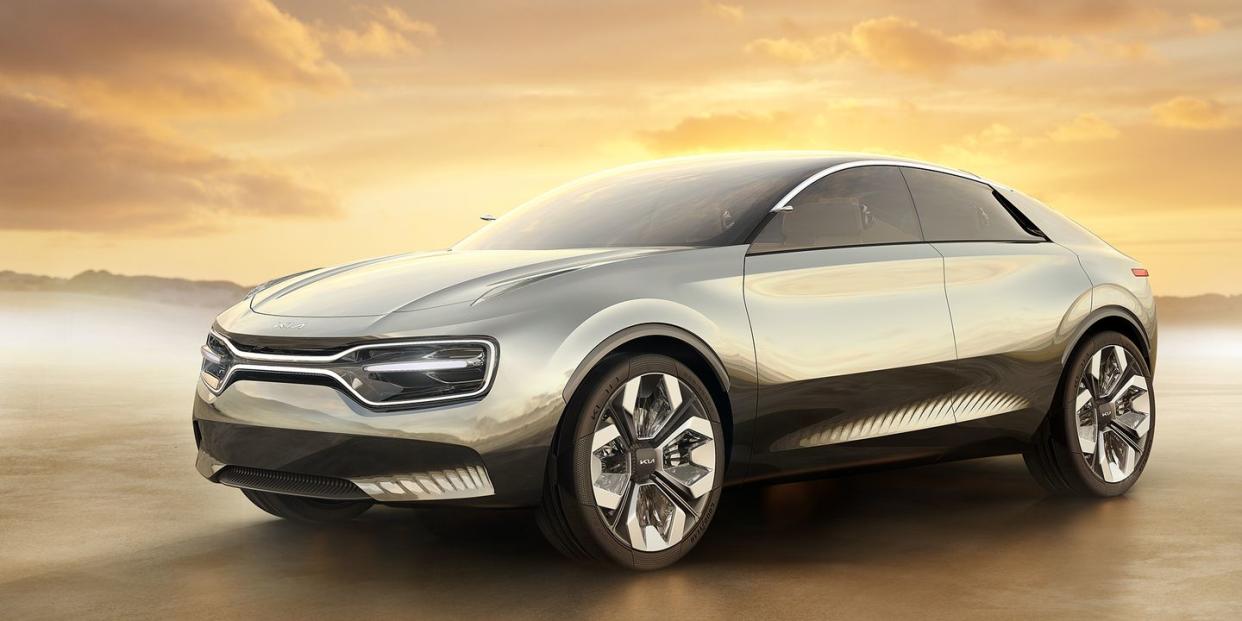
Kia's latest concept is a high-riding four-door electric car with a quirky name: Imagine by Kia.
It uses a new interpretation of Kia's signature grille shape, which now has been turned into a lighting element.
The European VP of Kia design wants the Imagine to give you goosebumps when you look at it. Well, does it?
Kia is preparing for the seemingly imminent electric future, and its newest concept, which has been revealed at the Geneva auto show, is the brand's first from-the-ground-up four-door EV. It's called the Imagine by Kia-yes, that's really the name-and European VP of design Gregory Guillaume says it was designed to get pulses racing and show that electric cars can be both exciting to drive and exciting to look at.
The Imagine is hard to assign a label to. It's high-riding like a crossover, has extremely raked rear glass like a fastback coupe, and is packaged like a sports sedan. This is all intentional, as Guillaume wanted it to be "a category buster, a disruptor." The Imagine's shape is most reminiscent of Kia's own Stinger-picture one of those with a taller body and futuristic details, and you're most of the way there. In size, the Imagine is on the larger side of the European C segment, which contains cars including the Ford Focus and the Volkswagen Golf. (The wheels are 22 inches in size, for scale's sake.)
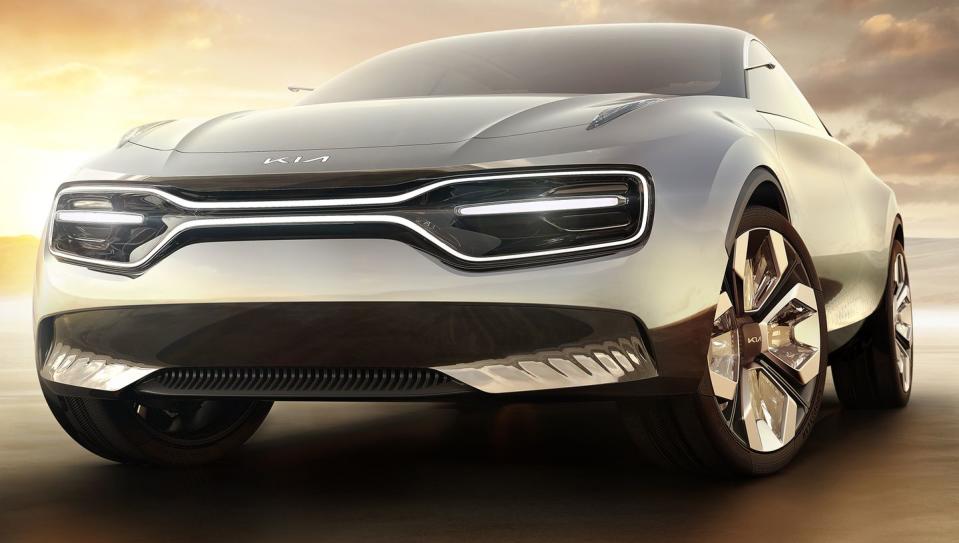
From the front, the Imagine is dominated by a new interpretation of Kia's tiger-nose grille. Kia calls it the tiger mask, and it essentially turns the outline shape of the tiger-nose grille into one large LED strip. The headlights themselves are thin LED strips located inside that outline, encased in clear acrylic, while the turn signals are located high up on the front fenders and set in protruding fins made of acrylic. Guillaume says the Imagine's tiger mask could become a "unifying design element" of Kia's future electric cars. The LED taillights ape the shape of those on the Kia Stinger, and the rear turn signals are set in "tunnels" to create a 3D effect. At both the front and rear of the car, the traditional (and boring) oval logo has been replaced by the brand name written in a new, modern script; it lights up as the driver approaches the car. Kia doesn't say, but we hope the new badge makes its way to future Kia production cars.
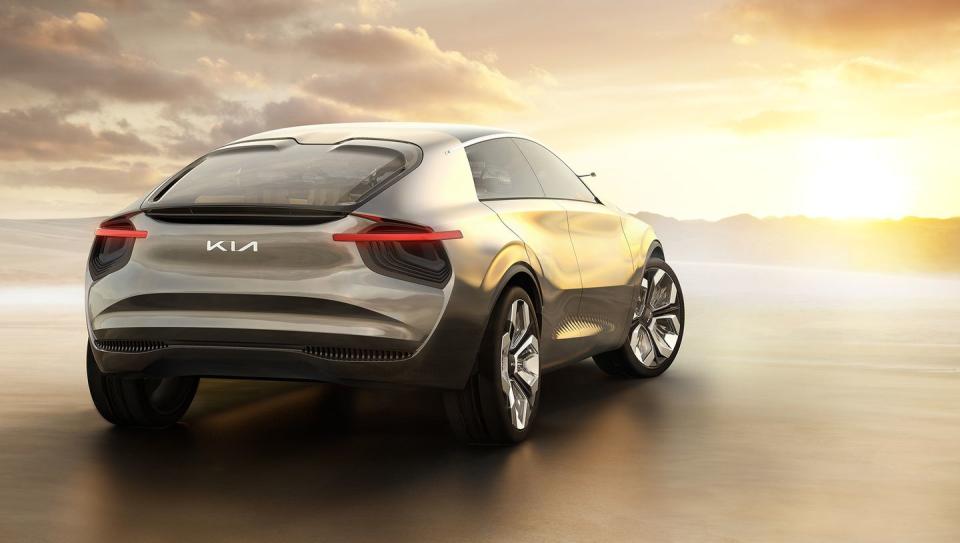
In lieu of traditional crossover-like lower body cladding, Kia has gone with an altogether different surfacing solution. The Imagine has a rippling effect stamped into the metal on the lower front bumper and bottom half of the door skins, and none of the "ruches" are the same in length and angle. The rest of the body is defined by taut creases that are amplified by the chromelike silver paint, which is tinted bronze.
The windshield and roof are one pane of glass, and the trim piece dividing it from the side windows lights up. Kia says that a lot of thought was put into the Imagine's aerodynamics, with features like the side-view cameras, smooth underbody, and hidden C-pillar vents aiding efficiency and reducing drag.
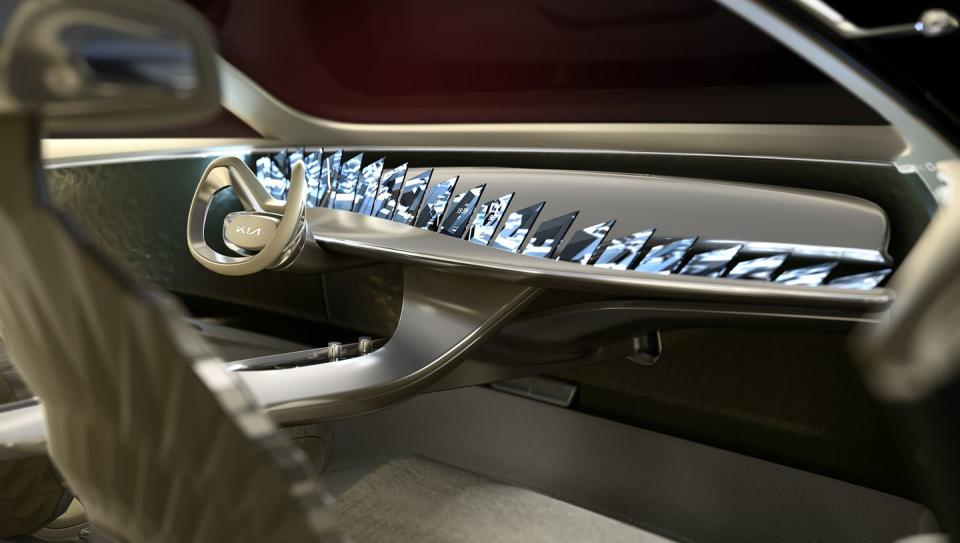
With the Imagine's interior, Kia is directly poking fun at other automakers. The relatively simple, sweeping dashboard is dominated by 21 screens that are placed atop it and curve their way across. Ralph Kluge, Kia's general manager of interior design, says the screens "are a humorous and irreverent riposte" to the competition between other automakers to produce the car with the biggest screens. When viewed from the driver's seat, the screens actually look like one large unit thanks to the clever positioning-in fact, they might be easier on the eyes than one giant screen-and the wavelike placement ties in with the car's exterior surfacing. The screens show typical infotainment functions including navigation and climate control, but the Imagine will also display images of past Kia concept cars.
The rest of the Imagine's interior is typical concept-car extravagance, too. The four seats are covered in leather and silk and have shells with a diamond-cut finish, and the door cards are covered in leather and a metallic fabric. The center console stretches back toward the rear seats and appears to float, an effect that is echoed by the mounts for the front seats. Refreshingly for a concept car in 2019, Kia makes no mention of an autonomous mode that sees the steering wheel fold away, although the pedals do disappear when the car is turned off.
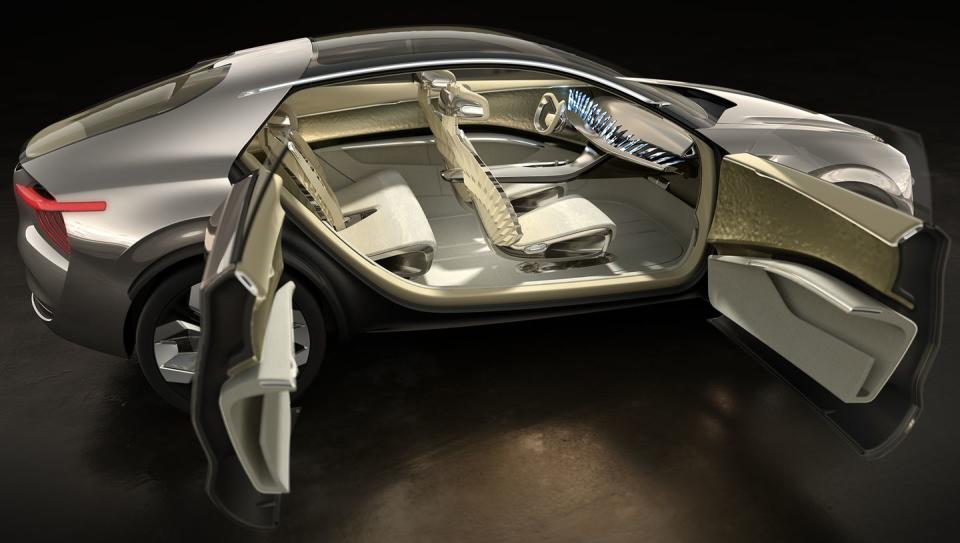
Sadly, Kia gives no actual details about the Imagine's platform or powertrain beyond saying it has a low-mounted battery pack with "a compact drivetrain." Kia does say that the Imagine is the company's first purely electric passenger car, so it doesn't share anything with existing Kia EVs like the Niro, and the car's proportions lead us to believe it's a rear-drive-based platform. The electric platform allows for a large rear luggage area accessed by the rear glass, a frunk under the hood, and a flat floor on the interior.
Take away all of the insane concept-car details, and it's not hard to imagine (get it?) a production car based on the Imagine. Vehicles shaped like this are extremely in vogue right now, and the way Kia talks about the design of the Imagine makes it seem the company wants to put it into production. Says Guillaume, "We imagined designing an all-electric car that not only answered consumer concerns around range, performance, recharging networks, and driving dynamism, but one that also gave you goosebumps when you looked at it and made the hairs on the back of your neck stand up when you drove it."
If that kind of thought and emotion get put into Kia's future production EVs, we're all for it-even if they get silly names.
('You Might Also Like',)

